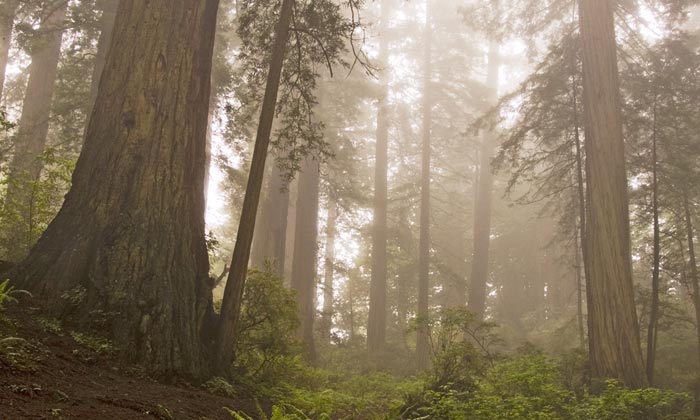
© 2011 Robert Hitchman. All Rights Reserved.
Damnation Creek Trail in Fog
Nikon D300s | 24mm lens | one sec. at f/18
Redwood National Park is a World Heritage Site and an International Biosphere Reserve. Prairie Creek Redwoods State Park is centered on the coast within this National Reserve. My favorite time to travel north into the redwoods is during the last week of May and the first week of June, the peak of the rhododendron blooming season. All through the summer, heavy coastal fogs often blanket the northern California Coast–perfect conditions for redwood forest photography.
The Coastal Drive heads west off Highway 101 just south of the Klamath River Bridge. Paved for a few miles, it soon becomes a narrow, rutted gravel road that climbs southward through the redwoods along the top of bluffs that drop to the Pacific Ocean. The many large groves of moss-covered red alders were one of the first trees to grow on clear-cut land (land where all the trees were removed at one time) creating a canopy of shade for slow growing evergreens to become established. The Coastal Trail can be accessed from this road. The Coastal Drive, the seven-mile-long Newton B. Drury Scenic Parkway, eventually joins the main road through Prairie Creek State Park. This was the old north/south Highway 101 that used to be the only route through this state park before a new freeway bypassed the heart of the forest.
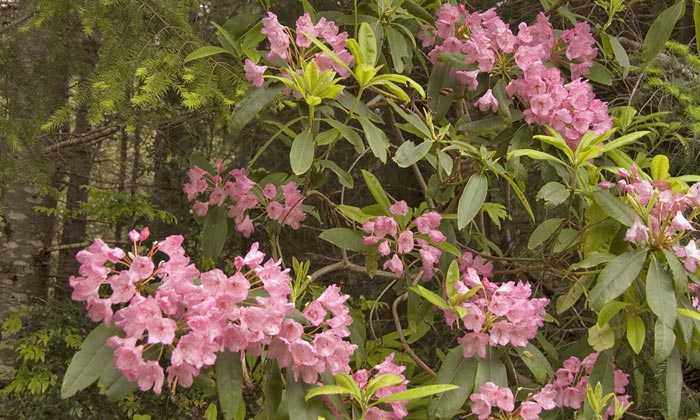
© 2011 Robert Hitchman. All Rights Reserved.
Rhododendron Blossoms
Nikon D300s | 35mm lens | 1/60 sec. at f/5.6
Wide parking areas are all along this drive at more than a dozen trailheads. Twenty-eight trails wind for a total of seventy miles through Prairie Creek Redwoods State Park. Some of these trails are short and easy; some are over ten miles long and strenuous. Some of the world’s tallest trees are still growing in this fourteen-thousand acre sanctuary, thanks to the generosity of Save-the-Redwoods League donors beginning in 1923.
For my trip, I was looking for groves of large, old-growth redwoods on the steep slopes and canyons on the east side of the park. The flat, alluvial plains and river flood plains I had been hiking were giving me photographs of redwood trees with all their bases aligned on a flat, straight base line. I needed some variety in my compositions. I asked some questions of the rangers in the Prairie Creek Visitor Center about locations of level hiking trails that follow ridge lines in the mountains on the east side of the park. The rangers pointed me to the Rhododendron Trail, an eight-mile-long trail that starts and ends at trailheads along the Scenic Drive, and climbs eight-hundred feet to a high ridgeline running north and south through the park. A road winds up to the ridge, to a spot near the middle of the trail.
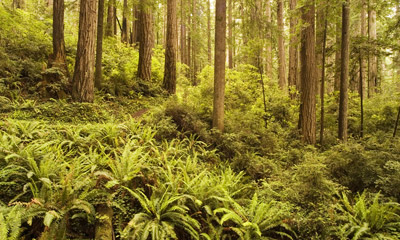
© 2011 Robert Hitchman. All Rights Reserved.
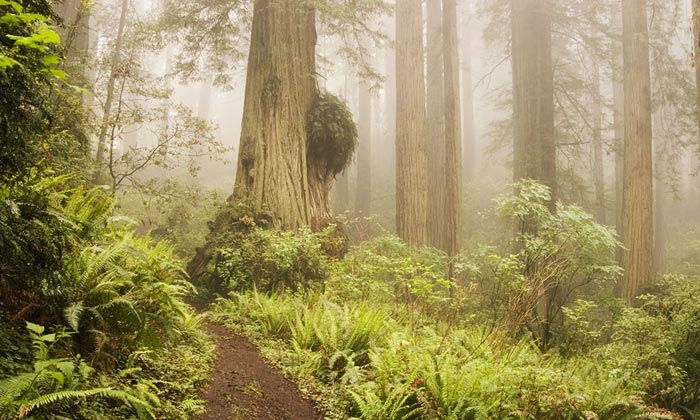
© 2011 Robert Hitchman. All Rights Reserved.
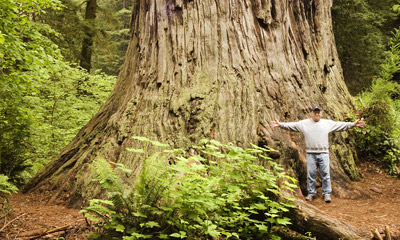
© 2011 Robert Hitchman. All Rights Reserved.
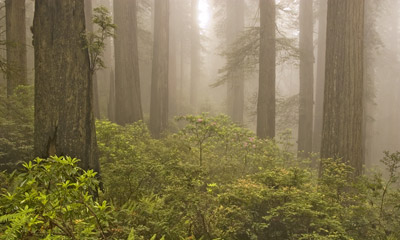
© 2011 Robert Hitchman. All Rights Reserved.
Rhododendron Trail
Nikon D300s | 15mm wide-angle lens | two sec. at f/22
Redwood Burl
Nikon D300s | 24mm lens |
1/2 sec. at f/18
Standing at the Base of
Ancient Redwood
Nikon D300s | 30mm lens |
1/4 sec. at f/16
Redwood Grove
Nikon D300s | 24mm lens |
1/2 sec. at f/18
The Cal-Barrel Road heads east off the Scenic Drive and climbs steeply through a dense forest. It’s narrow and unpaved, but can be driven with any vehicle, except large RVs and towed trailers. The Rhododendron Trail crosses the parking area at the end of the road. The southern part of the trail drops steeply. The northern part drops less than a hundred feet and then stays level for a mile-and-a half, to a junction with the South Fork Trail.
This stretch of the Rhododendron Trail is one of the better places for photographers looking for great redwood forest compositions. The trail winds in and out of heavily-wooded ravines, crossing small wooden bridges, larger plank bridges, and a fallen redwood log that has been flattened on top, just wide enough to cross a sixty-foot ravine. Every inch of the forest floor is covered with ferns, sorrel, moss-covered fallen logs and rhododendrons, along with some scattered hemlocks and vine maple. The ancient, old-growth redwoods almost block out the sunlight. It’s a classic rainforest, with small streams cascading down ravines and fog dripping from overhead branches.
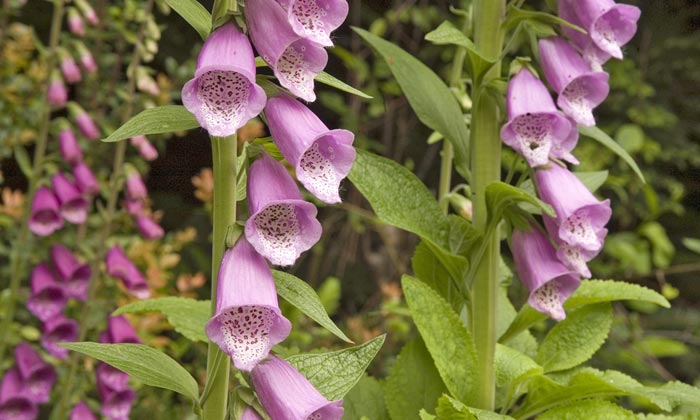
© 2011 Robert Hitchman. All rights reserved.
Foxglove
Nikon D300s | 80mm lens | 1/15 sec. at f/16
Pack a plastic ground cloth for this hike. The details at ground level are amazing. With a wide-angle lens on your camera attached to a tripod lowered to ground-level, you can create amazing vertical compositions with life-size maidenhair ferns in the foreground and an entire redwood tree rising beyond. If you want to avoid a distorted perspective, you can photograph trees rising from the slopes below you without tilting your camera up or down, or if you enjoy the distorted look in an image, you can lie on your back and shoot straight up, creating a star-burst effect of radiating tree trunks.
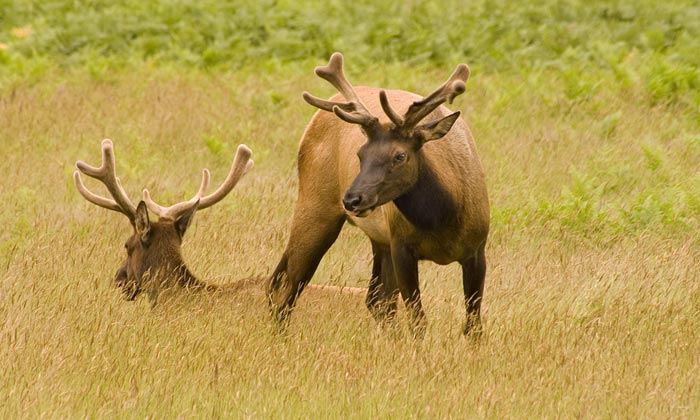
© 2011 Robert Hitchman. All rights reserved.
Two Bull Elk
Nikon D300s | 300mm lens | 1/200 sec. at f/8
From Prairie Creek, it’s a 347-mile drive back to San Francisco. After a full day of photography in Prairie Creek, I drove fifty miles south to Eureka, for an overnight stop on my way back home.
by Robert Hitchman, Photograph America

Leave a Reply